Butternut squash is the most popular squash for home canning.
The reason is that all winter squash must be peeled and cubed before canning, and butternut squash just happens to be the easiest winter squash to work with from both aspects.
You can just peel the butternut squashes with a vegetable peeler, then cut in half, clean out the small cavity, then use a French knife to chop into relatively uniform cubes.
Don’t worry about any pale green lines under the skin; they will disappear during processing.
The seeds are an incredibly good snack food when roasted; many people prefer them to pumpkin seeds.
You can use home canned butternut squash as a vegetable, or, in desserts such as pies.
There’s only one downside to butternut squash: it’s one of the wateriest winter squashes to start with (which is why people who aren’t canning it often bake it — to dry it out), so after opening a jar of it, be sure to drain well, even pressing a bit (you can save and freeze for soup all the liquid from the squash and jar.)
As for all low-acid foods, a pressure canner is absolutely required to home can butternut squash (and all squashes.) If you don’t have a pressure canner and still wish to preserve it, freeze it instead.
See here for canning other winter squash, and pumpkin.
Quantities of butternut squash needed
Numbers are approximate guidelines.
On average, as a very rough guideline, expect to need about 1 kg (2 ¼ lbs) of fresh, unpeeled butternut squash per 1 litre (US quart) jar of canned butternut squash.
- 7 kg (16 lb) of butternut squash = 7 litres (US quarts) canned butternut squash
- 4.5 kg (10 lbs ) of butternut squash = 9 x ½ litres (US pints) canned butternut squash
After-canning equivalents
- A drained litre (US quart) jar holds 750 g (1.6 lbs) 0f blanched butternut squash cubes (approx).
- A drained half-litre (US pint) jar holds 350 g (12 oz) of blanched butternut squash cubes (approx).
- 1 litre (US quart) jar home-canned squash or pumpkin, drained, mashed and drained again = 1 ¾ cups (400 g) mashed, “relatively dry” squash purée (drained to a dryness level similar to that of canned pumpkin purée)
The recipe
Jar size choices: Either half-litre (1 US pint) OR 1 litre (1 US quart)
Processing method: Pressure canning only
Yield: varies
Headspace: 3 cm (1 inch)
Processing pressure: 10 lbs (69 kPa) weighted gauge, 11 lbs (76 kpa) dial gauge (adjust pressure for your altitude when over 300 metres / 1000 feet)
Processing time: Half-litres (pints) 55 minutes; litres (quarts) 90 minutes
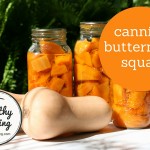
Home-canned butternut squash
Ingredients
Instructions
- Wash, peel and seed the butternut squash.
- Cut into 3 cm (1 inch) cubes.
- Blanch the squash cubes 2 minutes in boiling water.
- Pack into half-litre (US pint) jars or 1 litre (US quart) jars.
- Leave 3 cm (1 inch) headspace.
- Top up with clean boiling water (such as from a kettle, for instance), maintaining headspace.
- Debubble, adjust headspace.
- Wipe jar rims.
- Put lids on.
- Processing pressure: 10 lbs (69 kPa) weighted gauge, 11 lbs (76 kpa) dial gauge (adjust pressure for your altitude when over 300 metres / 1000 feet)
- Processing time: half-litre (US pint) jars for 55 minutes OR 1 litre (US quart) jars for 90 minutes.
Notes
Nutrition
Processing guidelines below are for weighted-gauge pressure canner. See also if applicable: Dial-gauge pressures.
| Jar Size | Time | 0 to 300 m (0 - 1000 feet) pressure | Above 300 m (1000 ft) pressure | |
|---|---|---|---|---|
| ½ litre (1 US pint) | 55 mins | 10 lbs | 15 lbs | |
| 1 litre (1 US quart) | 90 mins | 10 lbs | 15 lbs |
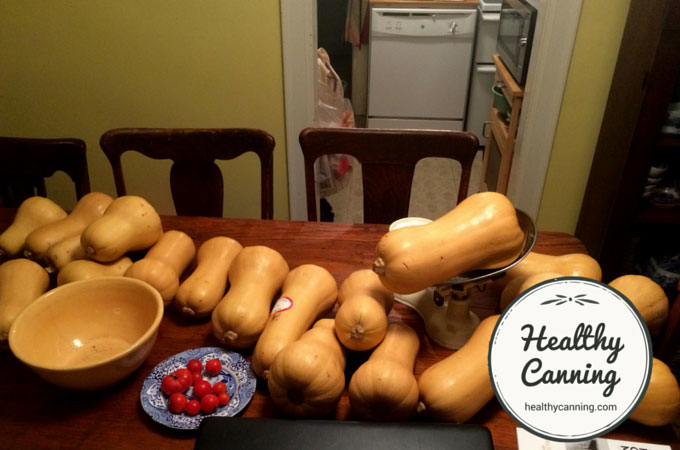
Waltham butternut squashes
Reference information
How to pressure can.
When pressure canning, you must adjust the pressure for your altitude.
More information about Salt-Free Canning in general.
Storage life of home canned goods
Nutrition
Serving size: 175 g, drained (about one half of a ½ litre / US pint jar, presuming the average jar contains a yield of 350 g solids.)
Per 175 g:
- 78 calories, 7 mg sodium
- Weight Watchers PointsPlus®: 175 g = 0 points (squash is free on Weight Watchers).
* Nutrition info provided by https://caloriecount.about.com
* PointsPlus™ calculated by healthycanning.com. Not endorsed by Weight Watchers® International, Inc, which is the owner of the PointsPlus® registered trademark.
Don’t waste the seeds!
You can “double dip” and get an extra bonus product out of your work besides canned butternut squash — namely, roasted squash seeds.
Roasted butternut squash seeds are very good eating.
To make them: wash the seeds. You don’t need to get all the little bits of squash off the seed — in fact, they are tastier with the little pieces of squash on them.
Toss in a bit of oil of your choice, and roast in a slow oven 125 C (250 F) for 10 to 15 minutes, tossing with a spatula half-way through.
Store in sealed container in the fridge. Good for a few weeks. (Or, freeze.)
You can season as desired with a nice salt substitute, some parmesan cheese, some chili powder, etc.
Two varieties of butternut squash for canning
There are two varieties of butternut squash for home canning. The first is the original butternut squash, which often has a curvy, narrow neck. The other is a more modern variety that is straighter, named Waltham butternut squash. You may can either interchangeably; they both taste the same.
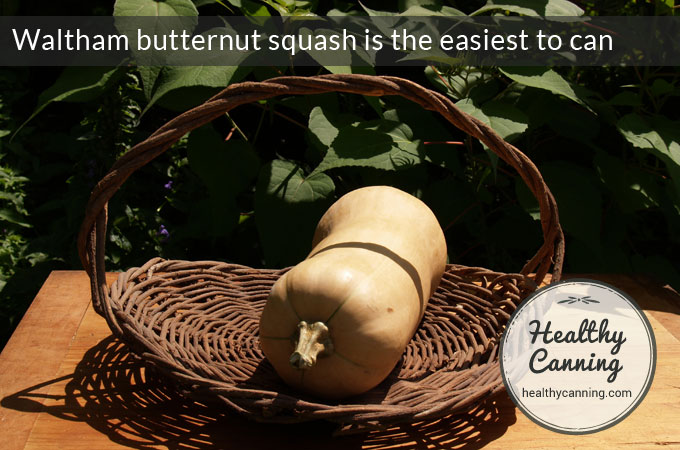
Waltham butternut squash is possibly the easiest squash to peel when raw.
Cooking with canning recipes
Source
Pumpkins and Winter Squash – Cubed. United States Department of Agriculture (USDA). Complete guide to home canning. Agriculture information bulletin No. 539. 2015. Page 4-18.

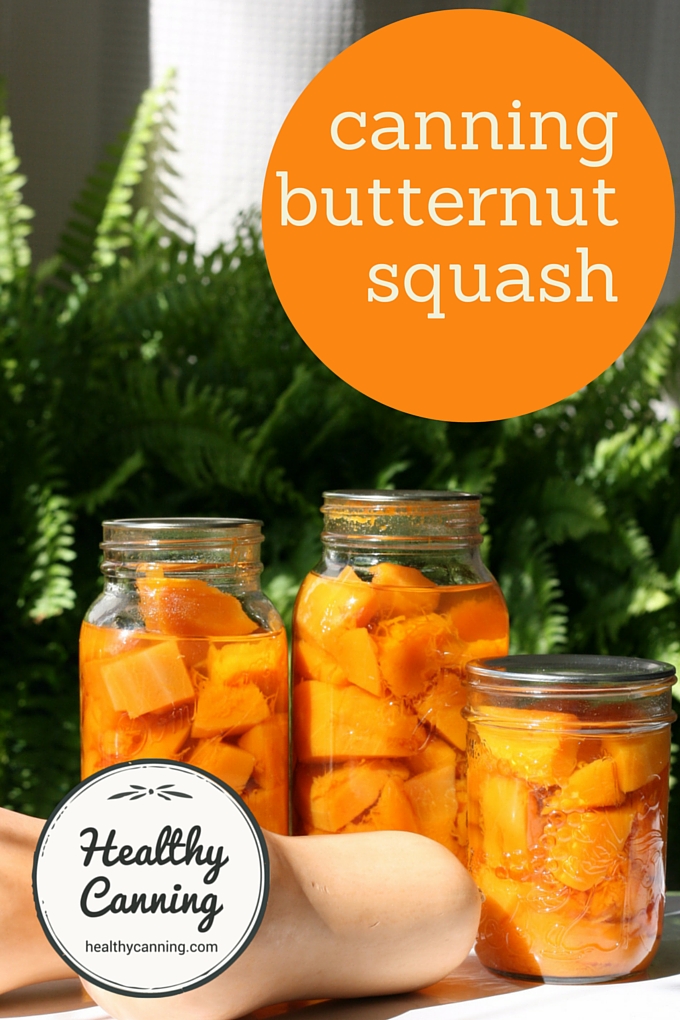
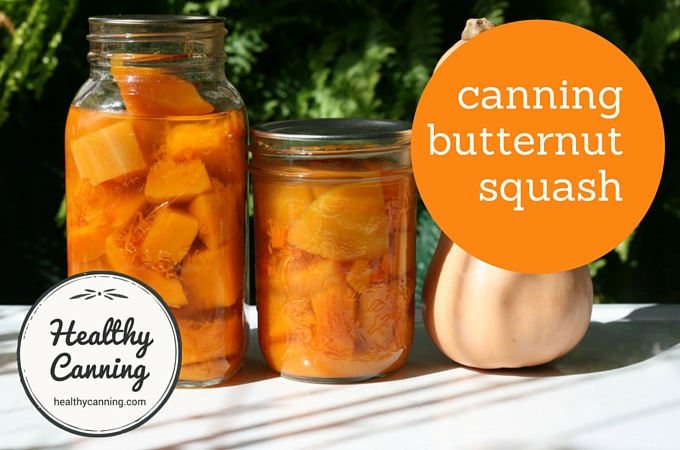
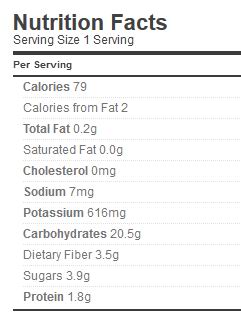
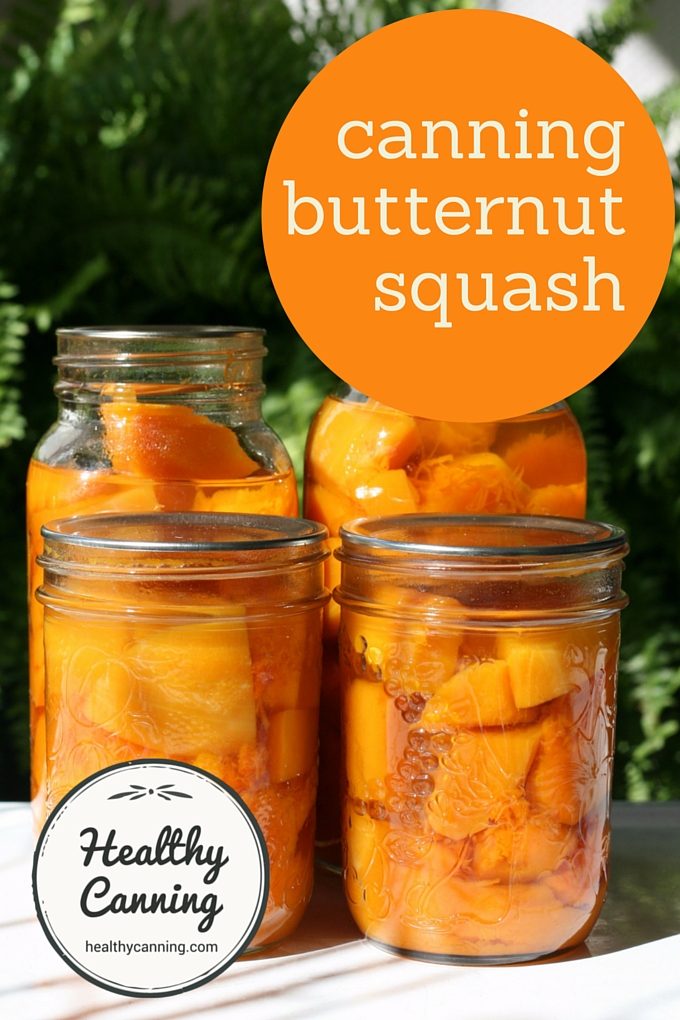
Eleanor
What is the shelf life of the bottled squash after pressure canning?
justin
I can see why I would blanch before freezing, but why before canning?
Healthy Canning
The blanching is driving oxygen out of the pieces to help prolong the storage life. It also enables the pieces to pack better into the jar. Also it heats them, getting them ready for processing.
Margie S
I canned butternut squash this year in my pressure canner and did the same as you. But the liquid in the jars looks very milky and cloudy. Is this normal? I did use some to make soup and it really didn’t have much taste.
Healthy Canning
If you followed directions to a T, you would be fine.
Francesca Haselden
Can this be done with other similar squashes, for example kabocha pumpkins?
Healthy Canning
Yes, see here: https://www.healthycanning.com/canning-pumpkin-and-squash
J. Rowe
Why take the chance?
Lynn
I cut my BN squash up and froze it. I’m going to try canning it this year.
Maureen Humm
Can I just process butternut squash in hot bath and not a pressure cooker?
Healthy Canning
See introductory notes at top of the page.
Elizabeth
I make a squash soup using onions, broth, garlic and butternut squash. Is there a reason it would not be ok to pressure can this? I am seeing not to purée squash but no reason why?
Healthy Canning
Can the squash as directed in cubes, then use the home-canned squash to whip up your soup recipe quickly on the fly as needed. The density issue of puréed squash is covered elsewhere on the site.
ruth mausehund
how long do you water bath butternut squash
Healthy Canning
O minutes is the time for that, because you freeze it instead, as water-bathing it is very unsafe.
Bobbie
Thank you for being a resource that helped.
Liz
The 90 min processing time slightly burnt my buttercup squash? Any reason why? It was my first try at squash.
Healthy Canning
Hi Liz, ask one of these Master Food Preserver groups what they think.
Roxanne Eberle
Liz, did you ever find out the answer to this question?
Liz
Hi,
No I didn’t.
I only canned buttercup once because the 90 minutes that it has to can seems to give it a slightly burnt taste. Is this normal or am I doing something wrong?
Healthy Canning
We have never heard of anyone detecting a burnt taste. Can you describe the canning process you used?
Roxanne Eberle
I don’t know yet either. I just canned some yesterday. When I try it, I’ll try to remember to let you know whether or not I found it to be burnt tasting.
Katie
Can you pressure can butternut squash pasta sauce? If so do you have any tips on how or would it be the same as the directions for canning straight squash? I would probably add some tomatoes paste, garlic and herbs…nothing crazy.
Healthy Canning
No, you can’t. Freeze it.
Ginger
I’ve looked through a lot of Butternut Squash soup recipe’s , but I haven’t found any that substitute frozen butternut squash for fresh. I have a lot of frozen butternut squash and would love to make soup and can it. Help!
Healthy Canning
Hi Ginger,
Ball has released a pressure canning recipe for Thai Squash Soup which is in their All New (2016, p. 284) and which is also online here: https://www.freshpreserving.com/thai-coconut-squash-soup—ball-recipes-br3637.html . You could leave out the seasonings to make it plainer. There is a possible catch. You didn’t say how you froze it, mashed or cubed, and the recipe does specify cubed which would be to allow correct heat circulation in the jars, and mashed would impact that. Another possible catch is whether Ball is okay with starting from squash cubes that have been frozen. The recommendation for freezing squash in cubes is to blanch it first (https://nchfp.uga.edu/how/freeze/squash_summer.html), and that could make it softer than Ball is expecting; they might break down in the canning and cause density issues. So, I’m going to have to suggest that, if that recipe interests you, that you should contact Ball and chat with them about it and see how it might suit your purposes.
But, as of winter 2018, that’s the only tested recipe from a reputable source that I’m aware of for a home-canned soup with winter squash in it.
Here’s an Extension Agent commenting on the question; looks like someone else was interested in the topic as well. https://ask.extension.org/questions/285979
I’d love if we had more tested recipes for squash soup, maybe even a puréed one, but right now, I think that’s about it!
Mary Lynn Heinen
You can use frozen butternut squash for your soup recipe. Use it as you would fresh. Enjoy!
JB Lewis
I plan to make soup containing squash and apples. What proportion of apple to squash would provide enough acidity that I could can the results in a hot water bath instead of a pressure canner?
Healthy Canning
Really, you’d need to hire a process specialist to determine what the recipe would need to look like to be safe and what processing method should be used. https://www.iftps.org/about.html I’m not sure it’s likely though that you’d get any answer saying hot water bath is fine.
If you want, you could ask a Master Food Preserver if fruit can be included among the ingredients in the USDA Soup recipe. https://www.healthycanning.com/usdas-your-choice-soup-recipe/ But that does require pressure canning.
You could freeze the soup instead. Or, can the two items separately as per the recommendations for each, then just make your soup upon opening.
I don’t know of any other recommendation I could pass on to you based on the literature that’s out there.
Meghan
Hi,
I canned a bunch of butternut squash this year, as always. For some reason, 2 of the jars have bits of floating white/grey material in the jars. The rest seem fine. Any ideas what it might be? Do you think it’s safe?
Healthy Canning
Meghan, check with one of the Master Food Preserver help groups here: https://www.healthycanning.com/master-food-preserver-help-groups/
Donna Johns
When you hot bath butternut squash, Do you add warm water to cover the pint jars & then boil for 55min?
It has been awhile since I have canned. I do not use a pressure canner, just a hot water bath method.
Healthy Canning
Squash can be preserved in these ways:
1) Find a recipe for squash pickles, pickle it, and hot-water bath the jars;
2) Pressure canning;
3) Freeze it.
4) Dehydrate it.
Attempting to water-bath can plain squash runs a high risk of botulism, and who the heck wants to do that just for some lousy squash? It doesn’t cost that much to buy.
Denise
Thank you for the recipe it was my first attempt at butternut squash which is always hard to peel and hard to cut especially for us older group i used a electric knife to cut the squash and it worked really well I just use a meat fork to hold it to keep my fingers away from the blade
Sandy
Never hat water bath veggies Only pressure can. You can help ITV water bath high acid foods such as tomatoes , fruit, etc